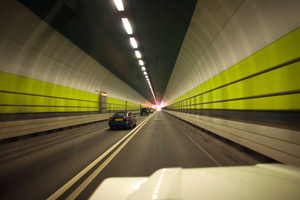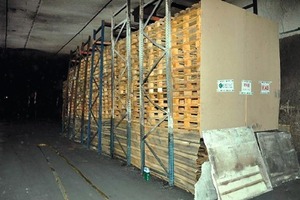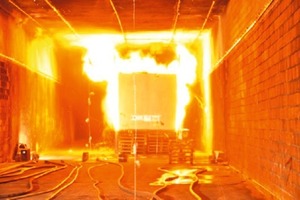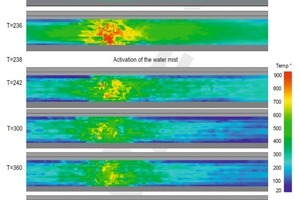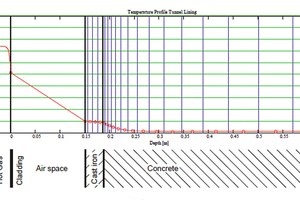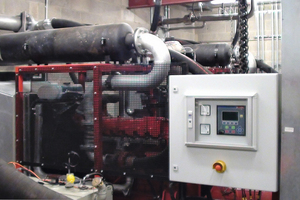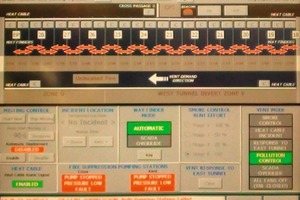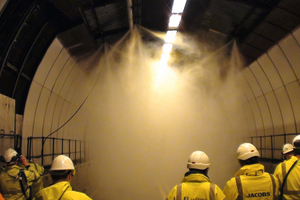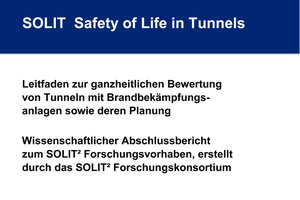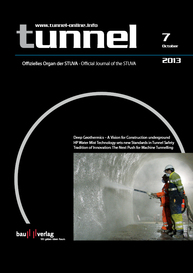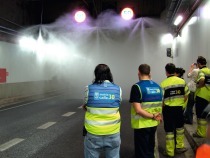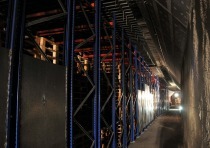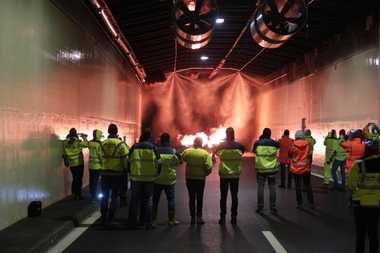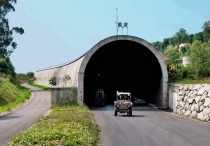Dartford Crossing: High-Pressure Water Mist Technology sets new Standards in Tunnel Safety
The “Dartford Crossing”, a complex comprising 2 tunnel bores and a cable-stayed bridge in the east of London, is numbered among the most important and busiest transport hubs in England. It was decided in 2010 to refurbish the 2 Dartford tunnels, as especially the older of the 2 British tunnels, completely built of cast iron and opened in 1963, represented a particular safety risk.
Starting Position
The Dartford Crossing, a complex comprising 2 tunnel bores (Fig. 1) and a cable-stayed bridge in the east of London, links Grays in Essex on the north side with Dartford (Kent) on the south side of the Thames. This part-section of the London M25 motorway ring is numbered among the most important and busiest transport hubs in England. Every day on average up to 150,000 vehicles use the 2 roughly 1,430 m long tunnel bores. The toll river crossing and the M25 motorway are run by the Highways Agency, a body belonging to the British Ministry of Transport.
The Highways Agency also decided the 2 Dartford tunnels had to be refurbished in 2010 as they no longer complied with current demands posed on fire protection. This decision was based on the European Parliament’s Guideline 2004/54/EC, in accordance with which all European countries are obliged to adopt minimum safety standards for tunnels on the trans-European highway network. The older of the 2 British tunnels, which was completely made of cast iron and opened back in 1963, represents a particular safety risk. The cast iron supporting structure is incapable of withstanding high temperatures over a lengthy time period. Furthermore the second tunnel bore, which was opened in 1980 to contend with the growing volume of traffic also had to be adapted to comply with modern safety standards.
Refurbishing Process
Objectives
The experts commissioned by the Highways Agency examined the possible refurbishing methods taking the following 3 criteria into consideration:
Preserving the Tunnel Structure and Availability of the Tunnel
Preservation of the tunnel structure and availability of the tunnel were accorded the highest priority. Should the structure of the 2 underwater tunnels collapse this would have resulted in the entire Dartford Crossing being lost. This would have substantially affected the transport infrastructure through the south of England. In addition, the closure of this strategically significant crossing would have had considerable economic implications, quite apart from a long term loss of toll charges. The closure of the Mont Blanc Tunnel after the fire disaster in 1999 – thus resulting in the temporary loss of one of the most important north-south links in the Alps – resulted in costs amounting to some € 2 billion for the Italian economy.
Safety of Human Lives
Improving the evacuation and rescue opportunities of tunnel users represents an important objective for the analyses. Heat and smoke gases spread within the shortest possible time in the event of a major fire. The longer and bigger the fire incident becomes, the quicker the chances of survival for people diminish.
Improving the Deployment Conditions for the Emergency Services
The rapid temperature development of a serious conflagration that spreads quickly, often prevents the emergency services from reaching the fire seat in time.
The older Dartford Tunnel posed particular challenges for the planning experts. Neither evacuation nor rescue routes could be subsequently installed on account of its cast iron structure. It was also impossible to clad the tunnel walls with fire protection panels: it would have been too enormous a task to dismantle the panels as needed for the regular inspection of the tunnel structure. The already mentioned criterion of availability also played a superordinated role during the deliberations on the concrete application of the refurbishing measures. Given the significance of the tunnel for the British infrastructure and the economy, it was essential that the measures were carried out in the shortest possible time without excessively interfering with ongoing traffic. After completing their investigations, the experts decided to install an active, water-based fire fighting system (FFFS/BBA). It was most suitable for fulfilling the predetermined protective goals as well as assuring relatively uncomplicated and subsequent installation in the existing tunnels. The high-pressure water mist was defined as a particular type of system.
In addition, all new components of the tunnel were evaluated in accordance with the Safety Integration Level (SIL in keeping with EN 61508) and classified as Stage 2. All new integrated systems – including the water mist system – had to fulfil SIL-2 requirements.
Major fire tests under real conditions as well as European research projects have on a number of occasions revealed the efficacy of active fire fighting systems for tunnels, especially for liquid fires. The positive cooling effect, which water mist systems generate under the tunnel ceiling, was an important factor in deciding to apply this technology for the Dartford Crossing. In order to accomplish the aim of protecting lives, both the authorities as well as the fire service insisted that the system was activated immediately after a fire was detected. The minimal space requirement, the high availabilities of already installed fire fighting systems and the low maintenance costs led to the decision to apply high-pressure water mist for refurbishing the Dartford Tunnel. ¹
Devising the Overall Safety Concept with integrated Fire Fighting System
Once the safety installations existing in the tunnel (e.g. detection system, ventilation) were analyzed, an overall safety concept was devised. The concept is based on the scenario of a serious truck fire and accords the BBA a key role: the fire fighting system has a positive effect on the entire tunnel infrastructure. It facilitates inspection of the structural conditions at any time and ensures that all systems present in the tunnel no longer have to be designed to withstand extremely high temperatures on account of the now reduced dimensioning fire curve, as would be required e.g. according to the RWS fire curve (RWS = Rijkswaterstaat). This diminishes the costs quite apart from making complex structural fire protection measures unnecessary. This can be displayed on the basis of the ventilation: in the case of a 100 MW fire the BBA reduces the smoke gas development so substantially that the ventilation can be designed to cope with a 30 MW fire rate.
The Institute for Applied Fire Protection Research (IFAB), Rostock/D, was commissioned to undertake the real fire tests geared to the special circumstances of this project. THE IFAB can point to extensive references for carrying out major real fire tests in tunnels, e.g. for the Groupe Eurotunnel S.A., the Mont Blanc Tunnel operating company and in the scope of the SOLIT2 research project.
The fire tests took place in the “San Pedro de Anes” test tunnel in Spain. This tunnel corresponds to a typical 2-lane road tunnel with a cross-section greatly resembling the original tunnel in England. It was possible to create identical ventilation conditions here, which helped to simulate the fire tests as realistically as possible. The fire test was undertaken by replicating a truck with Euro pallets (Figs. 2 + 3). A so-called target object was set up a certain distance away from the direction of flow by means of which just how the fire spread could be observed.
Numerous test instruments were installed in the proximity and further away from the fire load to obtain a range of measurement results for evaluation and designing the BBA. Thus for instance, temperature developments, smoke gas concentrations, the visibility and thermal radiation were measured and recorded at various positions and distances.
In keeping with the requirements particular focus was exerted on the temperatures in the ceiling area. The parameters of the BBA installation in the test tunnel correspond to the system subsequently installed in the Dartford Crossing: the type of nozzle, the horizontal and vertical gaps between the individual jets, the spraying angle, the distances between the jets and the fire load as well as the defined minimal pressure at the nozzle were determined here. The fire tests executed on this basis confirmed the efficacy of the high-pressure water mist system and the fulfilment of the intended protective measures.
Based on the fire tests the IFAB undertook CFD calculations (CFD = Computational Fluid Dynamics – Numerical Flow Circulation) with the aim of among other things simulating the thermal transmission into the tunnel structure taking the specific tunnel façade into account and evaluating it. The outcome revealed that the temperatures prevailing in the cast iron structure were considerably below the prescribed maximum limits and could be classified as non-critical regarding preserving the tunnel structure. The results for the later bore of the Dartford Tunnel made of concrete were also completely uncritical.
Among the major challenges of the test series was the test involving first activating the BBA system once the fire had reached a size of 30 MW (Figs. 4 + 5). Thanks to the efficient cooling and protection of the water mist the effect of temperature was maintained at a restricted level even above the fire load so that no risk ensued for preserving the tunnel structure.
Requirements on the BBA’s functional Safety
As already described high demands were posed on the functional safety of the control components complying with Safety Integrity Level Stage 2 to enable an incident threatening safety to be discovered and tackled immediately. Thus the BBA also had to be integrated in the SIL-2 compatible tunnel control and monitoring system. This meant in practice for example that the section valves were triggered redundantly in order to safeguard their functioning – even in the event of an activation unit failing. These strict SIL requirements can be mainly attributed to areas with particularly high demands on safety-related functions such as e.g. in the aviation, railway and nuclear industries.
Designing and Installing the High-Pressure Water Mist System
The Highways Agency awarded the contract for developing, designing, manufacturing, assembling, setting up and servicing the high-pressure water mist system in Dartford Crossing to the FOGTEC Brandschutz GmbH & Co. KG, which had already installed high-pressure water mist systems in important tunnels in recent years. The tunnels applied there were subjected to all comprehensive 1:1 fire tests as well as in some cases proving their worth within the scope of the UPTUN and SOLIT/SOLIT2 research projects.
The BBA in the Dartford Crossing complied with the demands of the UPTUN guideline and the SOLIT2 code of practice [2, 3]. The system is designed to operate for a period of 60 min. The existing detection devices (linear heat indicator, camera units) send an alarm to the tunnel control centre in the event of fire, which confirms it thus triggering the BBA in the relevant sectors. Triggering takes place over a total length of 75 m, comprising three 25 m long sectors. In the older, cast iron tunnel, there are 58 sections, in the newer one 59, intended for fire fighting purposes. Pure water without the use of additives is foreseen as the fire fighting medium. The water for the BBA must not be specially stored and disposed of.
A pumping station with water reservoir has been set up at both mouths of the tunnel. Each of these stations possesses 3 diesel-operated pumps, one of which in each case is redundant. Owing to the extremely high demands on the availabili-ty of the tunnels, the pumping stations as well as the pumping units were designed redundantly. Thus one pumping station suffices for the BBA, the other is redundant. The pumps are driven by diesel aggregates thus assuring permanent functioning capacity, completely independent of the external electricity supply (Fig. 6).
Apart from ensuring the BBA possessed Safety Level Stage 2 (SIL-2), the system was integrated in a further safety structure, the tunnel’s superordinated control system. The LSCS (LSCS = Life Safety Control System) is approved in keeping with the EN 61508. Such control systems have so far only very rarely been used in tunnel bores. For the first time a fixed fire fighting system was integrated in such a system in the case of the Dartford Tunnel (Fig. 7).
The pipelines installed in the tunnel are made of stainless steel – quality 1.4571 or 1.4462. The pipe couplings are welded, guaranteed a long service life and require little maintenance. The use of rubber seals was avoided in the pipelines as far as possible to assure as high a temperature constancy as possible and a long service life for the system. The low-maintenance nozzles have no moveable parts. Attributes such as a required service life of at least 20 years, minimizing the need for maintenance and the necessary reliability are essential given the tough surroundings.
The BBA’s main pipeline filled with water is insulated, fitted with trace heating and provided with a stainless steel jacket. The trace heating is activated as soon as temperatures hover above freezing point thus preventing the water from freezing.
Installing the BBA was linked with particular challenges. Owing to the high frequencies and significance of the Dartford Tunnel for the British transportation network the installation work could only be undertaken at night during extremely reduced time frames. The resultant restrictions called for detailed planning on the part of the installation team. In this connection, the FOGTEC was able to rely on experience gained from similar sophisticated tunnel projects in the past.
The setting up and commissioning of both pumping stations as well as the complete installation in the older tunnel has already been concluded. The spraying tests for approval purposes have also been carried out (Fig. 8). The high-pressure water mist for the older, cast iron Dartford Tunnel has been completed ready for operation. The installation operations in the newer tunnel are reaching their final stages.
Conclusion and Outlook
Installing the BBA in the Dartford Crossing sets new standards worldwide in the field of fire protection and tunnel safety. The integration of a SIL-2 control system marks a step towards the future.
National and international research programmes on tunnel safety such as UPTUN, SOLIT and SOLIT2 are gaining in significance throughout the world. The resultant codes of practice are being increasingly used as the basis for setting up new fire fighting systems in tunnels. National guidelines for active BBA have already been approved with water mist being incorporated as technology for fire protection. 2 The possibilities of compensation for other installations in the tunnel, the reduction of life cycle costs for the tunnel, a simplified means of refurbishing tunnels and last but not least the outstanding advantages provided for combating fires represent decisive arguments in favour of applying high-pressure water mist technology for fighting fires. The example of the Dartford Tunnel makes it evident that the entire investment and life cycle costs with BBA usually emerge to be less than without BBA whilst securing higher availability at the same time.

